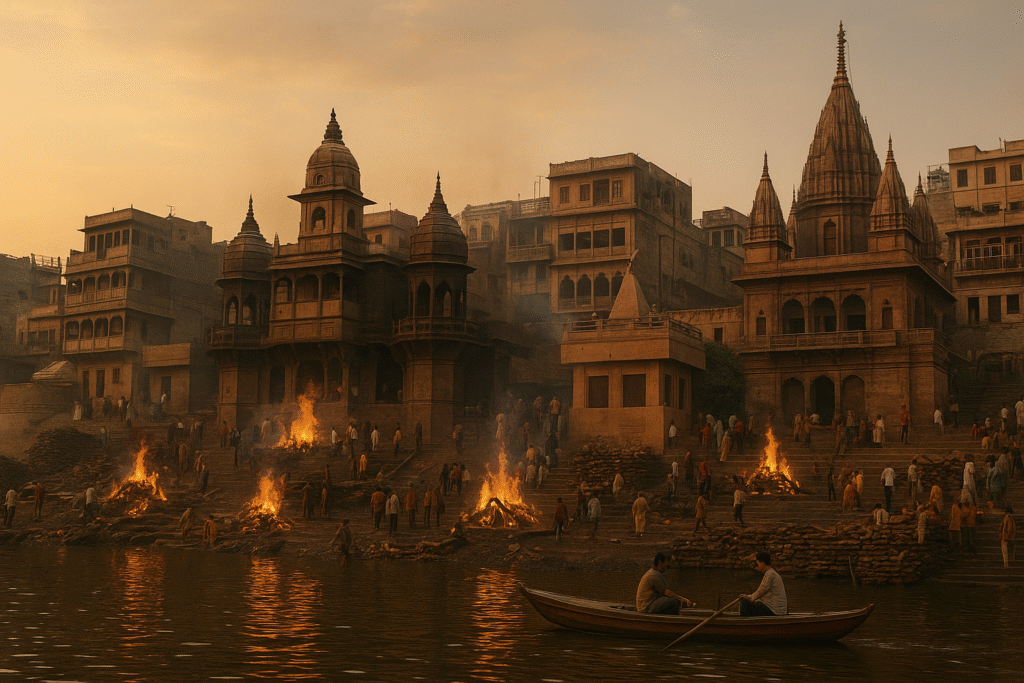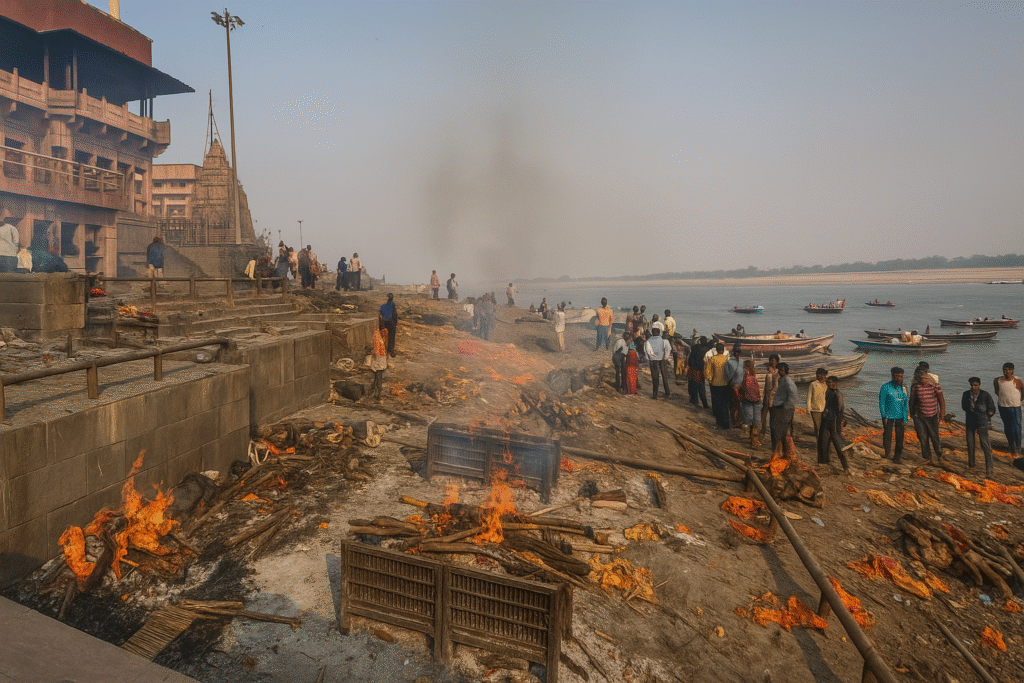Manikarnika Ghat – The Gateway to Moksha in Kashi
Manikarnika Ghat is not just a place; it is a gateway between life and death, between the temporary world and the eternal soul. Located in the heart of Varanasi (also called Kashi)—the oldest living city in the world—this ghat sits quietly on the banks of the sacred Ganga river, carrying thousands of stories, prayers, and ashes with its flowing waters.
Among the 84 ghats of Varanasi, Manikarnika holds a unique place. It is known as the main cremation ghat, where countless funeral pyres have burned without stopping for centuries. The fire here never dies—it is said to have been burning continuously for thousands of years.
But what makes this place so spiritually powerful?
Hindus believe that life is a cycle of birth, death, and rebirth—called samsara. The ultimate goal of every soul is to break free from this cycle and achieve moksha (liberation). Manikarnika Ghat is considered the most sacred place to leave the body because it is believed that the soul gets instant moksha if cremated here.
This belief is not just based on rituals—it is rooted in ancient stories, myths, and deep spiritual faith passed down through generations.

🌟 Why is it Called Manikarnika?
The name Manikarnika comes from two Sanskrit words:
“Mani” = Jewel
“Karnika” = Ear
So, Manikarnika means “the ear’s jewel.” But how did an earring give this sacred ghat its name? For that, we look into ancient Hindu mythology, which offers two beautiful stories behind the name.
- The Shiva-Parvati Story: The Divine Earring Falls
Long ago, Lord Shiva and Goddess Parvati were watching the sacred rituals performed at this very place in Kashi. While sitting near the Ganga, Parvati’s beautiful earring (mani) accidentally fell into the river.
When Shiva noticed it, he smiled and told Parvati that this place would become a sacred land where souls attain liberation. Because the “Mani” (jewel) from Parvati’s “Karnika” (ear) fell here, it became known as Manikarnika.
Some versions of the story say Shiva deliberately made the earring fall, to create this holy spot where he could stay and whisper the Taraka Mantra (salvation mantra) into the ears of the dead, granting them moksha.
- Sati’s Earring Falls – A Shakti Peeth
There’s another legend from the story of Sati and Shiva. After Sati jumped into her father Daksha’s yagna fire, Lord Shiva roamed the world carrying her burnt body in sorrow. To stop this, Lord Vishnu used his Sudarshan Chakra to cut her body into pieces, which fell at different places across India.
These spots became known as Shakti Peeths—powerful energy centers of the Goddess.
It is believed that Sati’s ear ornament fell at this ghat, making it one of the 51 Shakti Peethas. That’s why the place is called Manikarnika and is considered not just a cremation ground, but a divine seat of feminine energy (Shakti).
- Shiva’s Whisper of Liberation
It is believed that Lord Shiva himself visits this ghat, whispering the Taraka Mantra into the ears of the dying, helping them achieve moksha.
🕉️ Spiritual Importance
Manikarnika is not just about death—
- It is about liberation, peace, and divine connection.
- People believe that dying or being cremated in Kashi ends the cycle of rebirth.
- The soul finds direct entry into moksha, with the blessings of Shiva and Ganga.
- Saints, sages, and spiritual seekers from all over India come here to meditate on life and death.
This is why families from all over India bring their loved ones here for their final rites.
🔥 Cremation Rituals and Atmosphere
- Manikarnika Ghat is one of the only places in the world where cremation never stops.
- 24×7 funeral pyres burn all year long.
- The sacred fire used for cremation is believed to have been lit by Lord Shiva himself, and it has never been extinguished.
- Families perform Antyeshti Sanskar (last rites) with mantras, holy Ganga water, and sandalwood.
- The air is filled with smoke, mantras, prayers, and the sound of bells—creating an intense spiritual atmosphere that makes you feel the presence of eternity.
📍 Location and How to Visit
Manikarnika Ghat is located in Varanasi (Kashi), Uttar Pradesh, on the banks of the Ganga River.
It lies between Dashashwamedh Ghat and Scindia Ghat.
You can reach it easily by auto, boat, or by walking through the narrow lanes of old Kashi.
🚩 Nearby Places to Explore:
- Kashi Vishwanath Temple
- Annapurna Devi Temple
- Dasashwamedh Ghat
- Gyanvapi Mosque
What Manikarnika Teaches Us
Manikarnika Ghat teaches us the deepest truth of life:
“Everything in this world is temporary—body, wealth, name…
But the soul is eternal, and the journey continues.”
It reminds us to live with truth, humility, and purpose—and to understand that death is not the end, but the start of a divine journey.


Mind blowing read. Thank you for writing this.
Grateful for your time and interest. Stay tuned for more stories!”